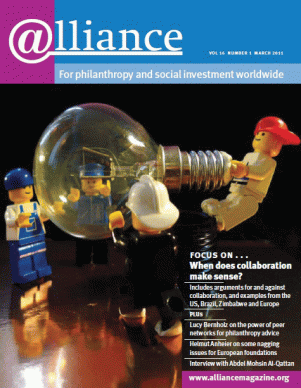While the spectrum of capital available for impact investing has grown significantly over the past two decades, and explosive growth has taken place in the kinds of institution involved in the sector, the field is still young and there is as yet no industry standard and little consolidation. There are two main challenges ahead: first, how can different forms of capital work together across institutional structures and constraints in order to deliver maximum social impact? Second, how can this be done at scale since scaling up requires both operational excellence and innovation in creating the kinds of hybrid institution able to attract many forms of capital.
While capital previously came only from philanthropic and government finance, today it also includes public equities, private equity, debt and venture philanthropy, as well as traditional philanthropy. Not-for-profit organizations, commercial organizations seeking market-based returns, quasi-commercial organizations that attract a blended form of capital, even government social welfare programmes – all are active in the sector. Ancillary organizations like social investment banks, consulting firms and network organizations have also increased significantly in number.
In the Indian healthcare sector, for example, the greatest need is to reach a low-income consumer base effectively by increasing efficiency, developing streamlined protocols and enhancing skill levels dramatically. The solution lies in developing hybrid business models where governments can work with the private and not-for-profit sectors through special-purpose vehicles that can attract philanthropic capital and public finance for market creation activities. This type of hybrid business also allows for scale up of operations, which in turn allows those businesses to hire the best talent available.
The challenge that still needs to be overcome is how to create hybrid legal structures with independent governance norms whose incentives are aligned in such a manner that philanthropic capital is not used as a cheap subsidy for greater returns to commercial investors. Creating structures where part of the commercial return goes back into the pool of philanthropic capital is, we believe, part of the answer. Regulatory reforms that allow innovative public-private initiatives to be established without unnecessary red tape would open the door to this.
In order for these structures to work, governments need to rethink their tendering processes so that organizations do not bid for and win tenders as loss leaders. This happens repeatedly in South Asia, and the winning bidder inevitably fails to deliver because of its cost structures. Not only is a transparent bidding process critical; its management must also be outsourced to organizations that understand the cost and income implications of tenders they receive.
Another crucial element is adequate capitalization. To achieve large-scale social impact, investments have to come in at the business’s critical growth period when working capital is stretched and traditional private equity firms won’t invest because their return expectations and timeframe don’t match the needs of the business. As a result, there is currently a significant lack of impact capital in the US$7 million to $10 million per investment range in this sector. In order for the not-for-profit sector’s assets to be made more efficient, hybrid for-profit structures need to be developed which can embrace a number of organizations. For example, many not-for-profit eye hospitals could roll up under one brand and focus on increased efficiency and protocols, and in turn have greater impact. These also need to be adequately capitalized so that they can attract the medical and management talent to do this.
Finally, there is a continuing need to encourage start-ups. In this regard, we believe there is not enough creative thinking in the use of public and not-for-profit sector assets. There are a few notable exceptions: the new social impact bond developed by Social Finance in the UK; and Life Spring Hospitals, a for-profit, low-cost, high-quality maternity hospital chain promoted by Hindustan Life Care, a Government of India healthcare company, and Acumen Fund, a global not-for-profit social venture fund.
Maximum impact can be achieved without huge advances in technology or a scattergun approach to supporting first-time entrepreneurs. By introducing appropriate hybrid investment structures and leveraging existing assets and infrastructure, investors can make a real difference in the social impact space.
Varun Sahni is managing director at Impact Investment Partners. Email varun.sahni@impactinvestmentpartners.com





Comments (0)